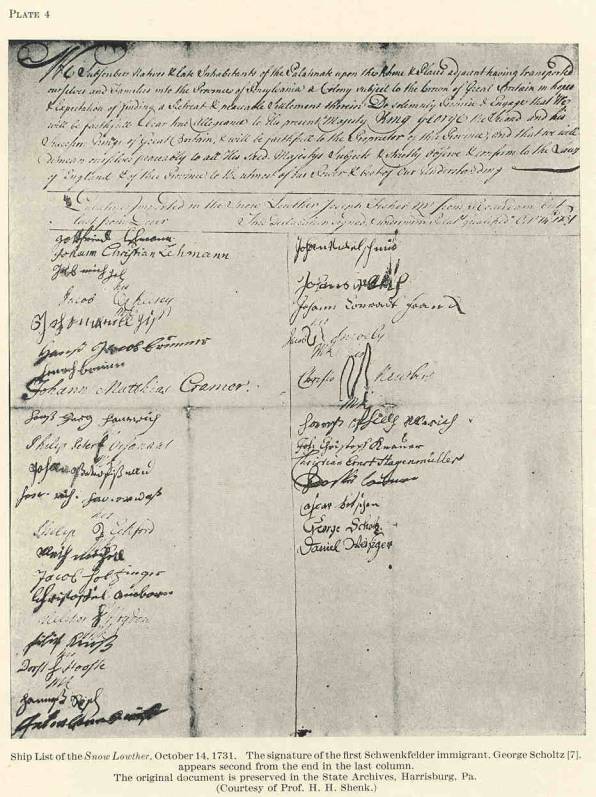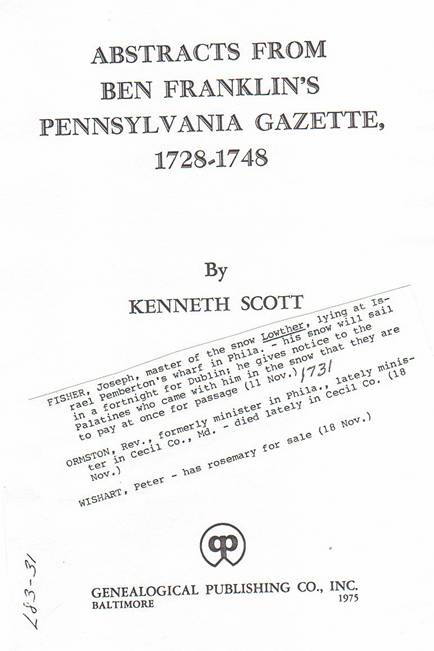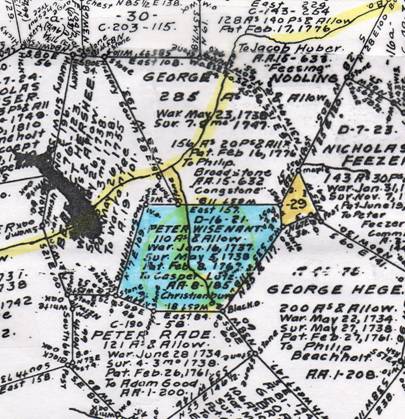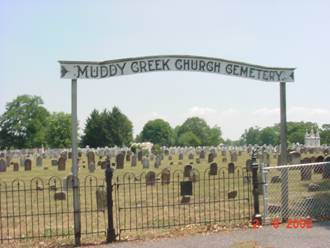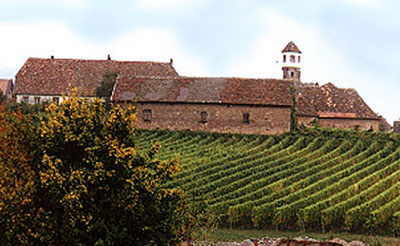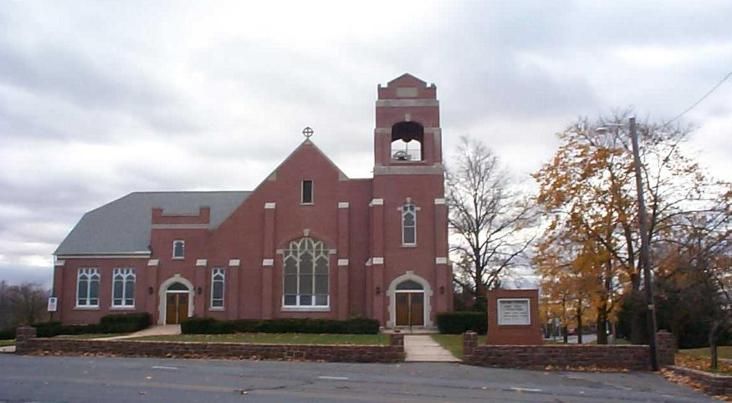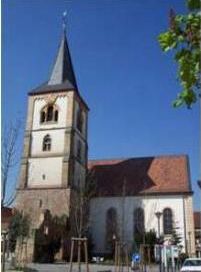The village of Hassloch is located in the Rheinland-Pfalz, east of Neustadt. Philipp "Fisenaut" was granted citizenship rights in Hassloch and was married July 9, 1710 to Helena Neff of Steffen, daughter of Peter Steffen. Philip Peter Visinand and his wife Helena had the following children:
ANNIA MARIA born May 2, 1711 baptized May 6, 1711; died in Germany before 1731.
JOHANN PETER born Feburary 4, 1714, baptized February 7, 1714; came to America with parents.
JOHANN NICKOLAUS born February 4, 1717 baptized Feburary 28. 1717; died in Germany before 1731.
JOHANN ADAM born Septembe 3, 1719 baptized September 1719; came to America with parents.
HEINRICH born September 27, 1722 baptized October 4, 1722; died in Germany before 1731.
MARIA MAGDALEN born onboard the Snow Lowther 1731, baptized in Pennsylvania.
Philip Peter Visinand with his wife and their TWO boys left Germany bound for America but arrived after seven months at sea with THREE children--John Peter Visinant, John Adam Visinant, and an un-baptized infant, Mary Madgdalen, who was born during the sea voyage. The family disembarked the ship "Snow Lowther" at Philadelphia, Pennsylvania, on October 14, 1731. In the book "Pennsylvania German Pioneers" Volume 1, 1727-1775, a full list is given for the German passengers on Board the ship Snow Lowther, list A includes all passenger, list B and C contains the names of all males above sixteen years of age who were required to sign the Oaths of Allegiance and Obligations. One son, John Adam, was under sixteen and did not sign the B and C list. When the ship docked in Philadelphia, Penn. seventy-eight natives of the German Palatinate Provinces walked down the gangway into freedom. There were thirty-three males above 16 years of age and forth-three women and children including males under 15, and two un-baptized infants not counted in the total of seventy-eight passengers. The ship namifest was made prior to leaving the home port; therefore a child born during the trip is not named as a passenger, nor counted at the destination entry.
The Swiss and German immigrants from the Palatinate and Wurttemberg were encouraged by William Penn to come to Pennsylvania. Many landed at Philadelphia seeking new homes and wanted their children to have religious training, but it became a problem to accommodate them with land. From Philadelphia many penetrated into the wilderness and finally came to settle in the part of Pennsylvania known as Cocalico. The Visanant family settled in the vicinity of Muddy Creek in Lancaster County, Cocalico Township, and became the Wisenandts where they are shown as early members of the Reformed Church. On May 19, 1743, the Muddy Creek Church was calling the Rev. Jacoby Lischy to be pastor of the church. Rev. Lishy required the call to carry the signatures of four elders and forty members before he would accept the call letter; Philip (Peter), Johann Peter and John Adam Wisenandt signed the article. In 1743, Johan Peter, Adam and Philip Peter Wisenandt all signed the Reformed Church Doctrine. During a visit in 2002, an obervation was made of the Church Records from 1733. Many of the children's baptism and marriages were listed in the book which was still in beautiful condition. Most of the records were under Wissenandt instead of Whisenant.
Philip Peter Whisenant obtained a land warrantee in 1737 in Pennsylvania. His land joined the nine acres that had been bought for Muddy Creek Lutheran Church. The Warrantee and plots of the land found in the courthouse at Lancaster, Pennsylvania, provides a landmine of information. Names of neighbors during that time reveal their contacts for baptism sponsors, wedding sponsors, and even proximity provided actual closeness that allowed courtship and marriage of neighbors!
Around 1744 Philip Peter Whisenant died and was buried in land reserved by the Muddy Creek Church, a church he had helped build and on land next to his own beloved farm. Muddy Creek Cemetery holds many unmarked gravesites. Unmarked by time,as many stones still stand, but cannot be read.
About 1758 the Peter Whisenant land was sold to Christian Lutz whom Maria Magdalen Whisenant had married in 1747. In early 1760's the Whisenant families migrated South. Maria was the only one of the family remaining in Pennsylvania.
The Whisenants left a trial of namesakes, first in North Carolina, then South Carolina, into Georgia and Texas.
Various spellings are used for this last name to include: Fisinant, Visanant, Visinand, Wisenant, Wissinand, Wissinandt, Whisonant, Whisnant, Whisnand and Whisenant, maybe even more. Some have connected the Whisenant family to the Whisehunt family, however, no research reveals a connection. A Whisenhunt family lived in North Carolina near the Whisenant family and even purchased land from a Whisenant according to Court papers, but no other connection was found. A supposition by some was made when Adam Whisenant's will in 1835 used the name of Whisenhunt, but he signed the document as "Adam Whisenant", so that should prove a clear title of Whisenant.
Research and presentation of 6th Great grandparents by Ross and Billye Schulle 2002
The village of Hassloch is located in the Rheinland-Pfalz, east of Neustadt. Philipp "Fisenaut" was granted citizenship rights in Hassloch and was married July 9, 1710 to Helena Neff of Steffen, daughter of Peter Steffen. Philip Peter Visinand and his wife Helena had the following children:
ANNIA MARIA born May 2, 1711 baptized May 6, 1711; died in Germany before 1731.
JOHANN PETER born Feburary 4, 1714, baptized February 7, 1714; came to America with parents.
JOHANN NICKOLAUS born February 4, 1717 baptized Feburary 28. 1717; died in Germany before 1731.
JOHANN ADAM born Septembe 3, 1719 baptized September 1719; came to America with parents.
HEINRICH born September 27, 1722 baptized October 4, 1722; died in Germany before 1731.
MARIA MAGDALEN born onboard the Snow Lowther 1731, baptized in Pennsylvania.
Philip Peter Visinand with his wife and their TWO boys left Germany bound for America but arrived after seven months at sea with THREE children--John Peter Visinant, John Adam Visinant, and an un-baptized infant, Mary Madgdalen, who was born during the sea voyage. The family disembarked the ship "Snow Lowther" at Philadelphia, Pennsylvania, on October 14, 1731. In the book "Pennsylvania German Pioneers" Volume 1, 1727-1775, a full list is given for the German passengers on Board the ship Snow Lowther, list A includes all passenger, list B and C contains the names of all males above sixteen years of age who were required to sign the Oaths of Allegiance and Obligations. One son, John Adam, was under sixteen and did not sign the B and C list. When the ship docked in Philadelphia, Penn. seventy-eight natives of the German Palatinate Provinces walked down the gangway into freedom. There were thirty-three males above 16 years of age and forth-three women and children including males under 15, and two un-baptized infants not counted in the total of seventy-eight passengers. The ship namifest was made prior to leaving the home port; therefore a child born during the trip is not named as a passenger, nor counted at the destination entry.
The Swiss and German immigrants from the Palatinate and Wurttemberg were encouraged by William Penn to come to Pennsylvania. Many landed at Philadelphia seeking new homes and wanted their children to have religious training, but it became a problem to accommodate them with land. From Philadelphia many penetrated into the wilderness and finally came to settle in the part of Pennsylvania known as Cocalico. The Visanant family settled in the vicinity of Muddy Creek in Lancaster County, Cocalico Township, and became the Wisenandts where they are shown as early members of the Reformed Church. On May 19, 1743, the Muddy Creek Church was calling the Rev. Jacoby Lischy to be pastor of the church. Rev. Lishy required the call to carry the signatures of four elders and forty members before he would accept the call letter; Philip (Peter), Johann Peter and John Adam Wisenandt signed the article. In 1743, Johan Peter, Adam and Philip Peter Wisenandt all signed the Reformed Church Doctrine. During a visit in 2002, an obervation was made of the Church Records from 1733. Many of the children's baptism and marriages were listed in the book which was still in beautiful condition. Most of the records were under Wissenandt instead of Whisenant.
Philip Peter Whisenant obtained a land warrantee in 1737 in Pennsylvania. His land joined the nine acres that had been bought for Muddy Creek Lutheran Church. The Warrantee and plots of the land found in the courthouse at Lancaster, Pennsylvania, provides a landmine of information. Names of neighbors during that time reveal their contacts for baptism sponsors, wedding sponsors, and even proximity provided actual closeness that allowed courtship and marriage of neighbors!
Around 1744 Philip Peter Whisenant died and was buried in land reserved by the Muddy Creek Church, a church he had helped build and on land next to his own beloved farm. Muddy Creek Cemetery holds many unmarked gravesites. Unmarked by time,as many stones still stand, but cannot be read.
About 1758 the Peter Whisenant land was sold to Christian Lutz whom Maria Magdalen Whisenant had married in 1747. In early 1760's the Whisenant families migrated South. Maria was the only one of the family remaining in Pennsylvania.
The Whisenants left a trial of namesakes, first in North Carolina, then South Carolina, into Georgia and Texas.
Various spellings are used for this last name to include: Fisinant, Visanant, Visinand, Wisenant, Wissinand, Wissinandt, Whisonant, Whisnant, Whisnand and Whisenant, maybe even more. Some have connected the Whisenant family to the Whisehunt family, however, no research reveals a connection. A Whisenhunt family lived in North Carolina near the Whisenant family and even purchased land from a Whisenant according to Court papers, but no other connection was found. A supposition by some was made when Adam Whisenant's will in 1835 used the name of Whisenhunt, but he signed the document as "Adam Whisenant", so that should prove a clear title of Whisenant.
Research and presentation of 6th Great grandparents by Ross and Billye Schulle 2002
Inscription
In 2000 there were about 120 sandstone memorial stones that were illegible because of wear. An assumption for Phillip Peter Whisenant's burial site is made since the Whisenant property was adjoining and they were also early members of the Muddy Creek Reformed/ Lutheran Union Church on this land. A History of the German Reformed Church http://www.rcus.org/brief-germany/ showing some possible motivations for their coming to America.




